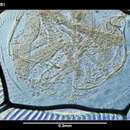en
names in breadcrumbs


"Bathyleberis, new genus
TYPE-SPECIES—Bathyleberis grossmani, described herein.
ETYMOLOGY—The generic name "Bathyleberis" is derived from the Greek "Bathyal" [ = deep] and "leberis" [= sloughed skin]. Gender: feminine. This new genus contains three new species described herein, B. grossmani, B. oculata, and B. monothrix; males are unknown.
DIAGNOSIS OF GENUS—Carapace: Carapace elongate without ornamentation; list on posterior infold with hyaline spines and bristles between them; infold between list and posterior valve margin with or without bristles and processes.
First antenna: Sensory bristle with 7 long terminal filaments on B. grossmani and 1 short proximal and 6 long terminal filaments on B. monothrix and B. oculata; d-bristle about one-half length of e-bristle on B. grossmani, about three-fourths length on B. monothrix, and about one-fifth on B. oculata; d-bristles tapering, with marginal spines on some species.
Second antenna: Medial and lateral surfaces of protopodite spinous or bare.
Mandible: Tip of ventral branch of coxale endite with 3 teeth. Dorsal margin of basale with 1-4 midbristles and terminal pair. Exopodite reaching about middle of dorsal margin of 1st endopodite joint and with 2 short bristles on hirsute tip. Dorsal margin of 2nd endopodite joint with long lateral bristle between b- and c- bristles.
Sixth limb: Anterior margin of limb of B. grossmani with 6 or 7 bristles; anterior margin of limb of B. monothrix with only 1 (on upper suture); anterior margin of limb of B. oculata with 2 bristles.
Seventh limb: B. grossmani with 6 proximal and 6 distal bristles and terminal combs with 9 teeth; B. monothrix with 8 proximal and 6 distal bristles and terminal combs with 14-17 teeth; B. oculata with 6 proximal and 6 distal bristles and terminal combs with 20 or 21 teeth.
Furca: Limb normal for subfamily.
Eyes: Medial eye well developed with or without hairs. Lateral eyes absent on B. grossmani and B. monothrix, well developed on B. oculata.
COMPARISONS—The only previously described genera in the subfamily with a well-developed d-bristle on the 1st antenna are Dolasterope, Empoulsenia, Skogsbergiella, and Archasterope. On these four genera the d-bristle is a filament with almost parallel sides from the base to the tip, which is either rounded and bears a minute spine, or is blunt. The d-bristle on the 1st antenna of Bathyleberis tapers from the base to the tip and may bear faint marginal spines. B. grossmani also differs from species of Archasterope, Empoulsenia, and Skogsbergiella in having 6 or 7 bristles on the anterior margin of the 6th limb.
DISTRIBUTION—Bathyleberis is represented in the study area in the Atlantic and Pacific Oceans and in the vicinity of New Zealand. The northernmost latitude at which it was collected is 41°S; the southernmost latitude was 61°S. Species in the genus were collected at water depths of 71 to 4303 m." (Kornicker 1975b, p.538-539)